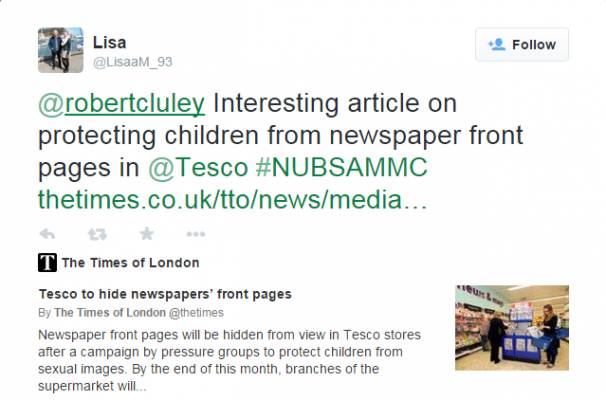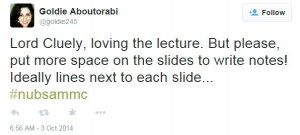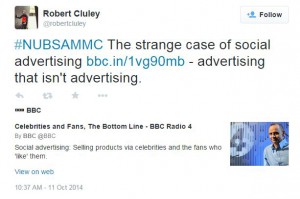
February 16, 2015, by Teaching at Nottingham
#NUBSAMMC – Combining Teaching with Twitter in the Business School
Convention dictates that students put their phones away during lectures, but this rule isn’t quite so applicable in Dr Robert Cluley’s sessions due to his use of Twitter as a tool to facilitate and enhance communication and the sharing of resources with and amongst students. Convening an undergraduate Advertising and Marketing module in the Business School, with around 250 third year students, has encouraged Robert to look to more creative strategies for engaging and inspiring students who are digitally literate and constantly connected to their smart devices:
“Over the Summer I was doing some research on Twitter; a lot of advertising agencies use it, they love new media stuff. When a colleague and I looked at the tweets that these agencies were sending they were actually incredibly rich texts – very rarely were they just the tweets themselves, they would be pointing you to a web page, an article or a YouTube video. So, because the advertising course is quite practical, I thought I would retweet anything that was particularly interesting or which was a fun example I could use in my teaching. Originally I was just doing it for myself, but soon I realised it would perhaps be beneficial for the students too.”
Whilst initially Robert’s plan had been to use a Twitter profile as a sort of portal, a way of aggregating interesting, relevant, topical resources for students to access, the creation of a module-specific hashtag has helped make it more user-friendly still:
“I came across a couple of articles where other academics had used a hashtag rather than a Twitter profile, as a way of providing a venue for students to engage through Twitter with these resources – it’s not just consuming it, but adding to it.”
The hashtag #NUBSAMMC (Nottingham University Business School: Advertising, Media, Marketing, Communications) can be attached to tweets to affiliate comments with the module, and can also be used as a search term for anyone looking to access an aggregated collection of relevant material. Engaging students in the learning process is one of the most valuable elements of Robert’s teaching strategy, as he explains:
“One of the main driving points was this idea of a ‘backchannel’ form of communication – I teach in a huge lecture theatre in the Business School, with an enormous gap between the lectern and the seats. It’s very difficult to get a sense of what the students are doing, so I thought this would open up a channel of communication where I could say ‘you’ve all got your smartphones on, if there’s something that’s interesting during the lecture: tweet about it. If there’s something you’re not sure about: tweet about it… Having the hashtag has provided an opportunity for me to say to students ‘if you think I could have covered a particular concept in more detail or if you’ve thought of a really great example of what I was talking about, here’s a place where you can share it’… For example, somebody had put up a link to a YouTube video, which I could then respond to online and actually talk about and use as an example in the next lecture. It’s not a fully co-produced course, but it provides a way of getting some ideas from the students as a big cohort and then presenting them back to them.”
Occasional WiFi connectivity issues may preclude Robert from having a live Twitter feed running on the projection screen behind him during lectures, but he is not put off by students using their phones whilst he’s teaching. This may seem counter-intuitive, but there’s reasoning behind the strategy:
“In media studies they talk about the Second Screen Generation – people increasingly watch TV and have their phone on. If anyone’s sat amongst students in a lecture theatre lately they’ll know that virtually everyone has their phone on; rather than being a distraction, I think about it as a way of populating the students’ phones with something that’s actually relevant to the class.”
As well as providing a way of aggregating content for easy access and fostering a sense of engagement with the module, the #NUBSAMMC hashtag enables students to communicate quickly and easily with one another and with Robert:

“One student had tweeted about wanting more room on the lecture notes, accompanied by a picture of a sheet of paper covered in scribbles; another student responded saying that they had plenty of space on theirs and that they didn’t need more paper. They were able to have a conversation between themselves – about the sustainability of printing lecture notes! – and I could then come in later on and contribute to the discussion… Afterwards they both tweeted back to say how great it had been to be able to communicate like that.”
Feedback from students has been overwhelmingly positive, but Robert’s approach has not been without its teething problems. Whilst incorporating Twitter into teaching has enabled Robert to harness the technological literacy of his students, it quickly became apparent that the digital world is their domain; some initial tweets from students poked fun at his appearance, but Robert insists that this is nothing to take personally:
“When I first saw those tweets I was a bit annoyed, but then I realised that’s just how the students naturally use the media. If I’d said ‘please use Twitter appropriately’ I think it would have just shut down – trying to police it would make it less of a social medium and more of a university medium. It’s not a personal attack on me, it’s just how they use Twitter and actually a number of the students that were tweeting those things in the beginning are the ones who are highly engaged with it now. My theory was to make the hashtag their space to do with what they want – although obviously if anyone were to go too far I would step in.”
The benefits of using Twitter and the #NUBSAMMC hashtag, for the students on Robert’s Advertising, Media, Marketing & Communications course, are clear – offering a neat digest of interesting links, providing an avenue for feedback and questions, and pro-actively engaging students with the module content. So far around 100 students follow Robert’s Twitter profile, and with the profile and hashtag content accessible without signing up it’s likely that this number is a conservative reflection of student engagement with the medium. Nearly 170 tweets have so far been produced featuring the #NUBSAMMC hashtag and the majority of students on the course have reported engaging with Twitter at some point during the semester. With such positive feedback, Robert is already thinking about ways of expanding this approach to integrate more activities, encouraging students to engage online with the module and with each other:
“I try to sell it to students by explaining that it’s not a competition; if you share knowledge everybody benefits. Twitter offers a place where you can do that.”
For more information on the Advertising, Media, Marketing & Communication module please contact Dr Robert Cluley via the Nottingham University Business School.
Support and advice about Learning Technology is available through the Libraries, Research and Learning Resources pages.
No comments yet, fill out a comment to be the first


Leave a Reply